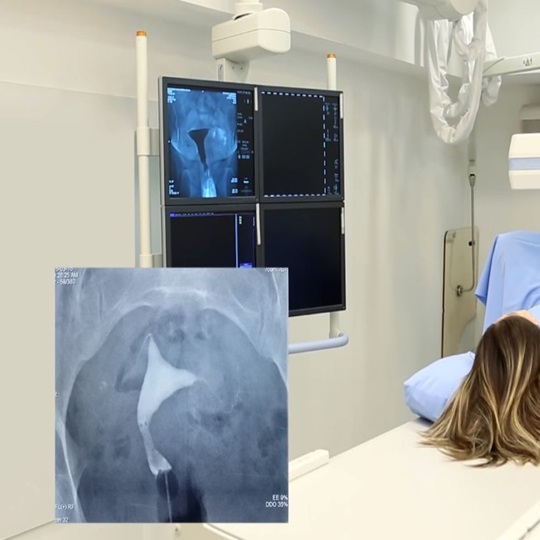What is the Difference Between Hysterosalpingography and Hysteroscopy?
Uterus Film | Hysteroscopy and hysterosalpingography are two different medical imaging methods used to examine the uterus. Both help evaluate the structures inside the uterus, but they are performed for different purposes and methods.
Hysteroscopy:
Hysteroscopy is a minimally invasive procedure used to directly view the inside of the uterus.
In this procedure, a thin telescopic instrument called a hysteroscope is inserted through the cervix and into the uterus. This instrument contains a camera and a light source and is used to view the inside of the uterus.
Hysteroscopy is used to evaluate and diagnose structural problems in the uterus, such as polyps, fibroids, adhesions, or other abnormalities.
It can also be used for minor surgical procedures, such as removing polyps or adhesions.
Hysteroscopy (Hysterosalpingography):
Hysteroscopy is a radiological imaging method used to view the uterus and fallopian tubes.
During this procedure, a contrast agent is injected into the uterus and its spread is monitored and recorded with an X-ray imaging device.
Hysteroscopy is used to evaluate the patency of the fallopian tubes, structural abnormalities within the uterus, blockages in the tubes, or other problems.
This procedure is often performed to understand the causes of infertility and is usually done as part of infertility treatment.
In this way, hysteroscopy is used to directly observe the inside of the uterus, while hysterosalpingography is more commonly used to evaluate the structural and functional status of the uterus and fallopian tubes. Both play important roles in the diagnosis and treatment of infertility, but they are used for different procedures and purposes.
Hysterosalpingography (Uterine Film)
Hysteroscopy is a medical imaging procedure performed to evaluate the structural and functional status of the uterus and fallopian tubes. During this procedure, a contrast agent is injected into the uterus and its spread is monitored with an X-ray imaging device. However, it is not recommended to get pregnant in the month when the hysterosalpingography is performed, and there are some important factors in this regard.
Effect of Contrast Agents: The contrast agents used during hysteroscopy are injected into the uterus and expelled through the fallopian tubes. These agents can take several days to be eliminated from the body, but most are usually expelled within a few hours.
Hysterosalpingography Date: Hysteroscopy is a test usually performed a few days after the beginning of the menstrual cycle. This is performed before ovulation occurs and fertilization (fertilization of the egg) has occurred.
Pregnancy Risk and Precautions: However, in case of any uncertainty, it is important for patients who will have a hysterosalpingography to follow their menstrual cycle calendar and their doctor’s recommendations to exclude the possibility of pregnancy before the test in order to reduce the possible risk of pregnancy. Additionally, contraceptive methods should be used after a hysterosalpingogram to minimize the risk of pregnancy.
As a result, it is important to be careful to rule out pregnancy before testing in the month when the hysterosalpingogram is done.
What is Revealed in a Hysterosalpingogram?
Fallopian Tube Status: Hysterosalpingography is used to assess the patency and functionality of the fallopian tubes. Blockages or narrowings in the tubes prevent the spread of contrast material, allowing these conditions to be detected.
Uterine Anatomical Abnormalities: Hysteroscopy is used to identify anatomical abnormalities in the uterus. Polyps, septum, fibroids, or other structural problems can cause significant changes in the spreading pattern of the contrast material, and these conditions can be detected during the hysterosalpingography.
Detection of Uterine Adhesions: Hysteroscopy can also be used to identify adhesions or adhesions in the uterus. These adhesions can prevent the spread of contrast material in the uterus, and this can be seen during the hysterosalpingography.
Detection of Causes of Infertility: Hysteroscopy is often used to understand the causes of infertility. In particular, since blockages in the tubes or abnormalities within the uterus can lead to infertility, these conditions are detected by hysterosalpingography, which plays an important role in treatment planning.
In conclusion, Hysteroscopy is an important tool for assessing the anatomical and functional status of the uterus and fallopian tubes. This procedure can help detect a number of conditions and determine the causes of conditions such as infertility, which plays a critical role in treatment planning.
After Hysteroscopy
Hysteroscopy is a minimally invasive medical procedure used to directly view and examine the inside of the uterus. Hysteroscopy is usually performed to evaluate and treat structural problems inside the uterus. There are some factors to consider regarding the time it takes to have intercourse after hysteroscopy:
After the Procedure: After hysteroscopy, women may experience symptoms such as light bleeding, cramping, and uterine pain. These symptoms may vary depending on the intensity of the procedure and the techniques used.
Healing Process: Hysteroscopy involves the use of an instrument that is inserted into the uterus, and therefore can cause minor damage to the tissues inside the uterus. This damage usually takes a few days to heal.
Doctor’s Recommendations: The recommendations of the doctor performing the procedure are important. Doctors usually recommend waiting a while before having intercourse after hysteroscopy. This period can usually be a few days or weeks after the procedure.
Personal Discomfort Level: Women’s levels of discomfort after hysteroscopy may vary. Some may experience mild discomfort, while others may experience more pain and discomfort. Therefore, it is important to consider their personal comfort level when it comes to having intercourse.
Complication Risk: Infection or other complications may develop after hysteroscopy, although rare. In this case, it is important to follow the follow-up and treatment plan determined by the doctor.
As a result, the period of sexual intercourse after hysteroscopy can usually extend to the day of the procedure or a few days later. However, since each situation is different, Assoc. Prof. Dr. Esra ÖZBAŞLI’s recommendations and personal discomfort level should be taken into consideration.







